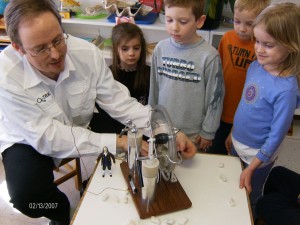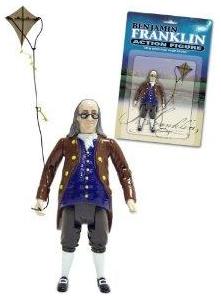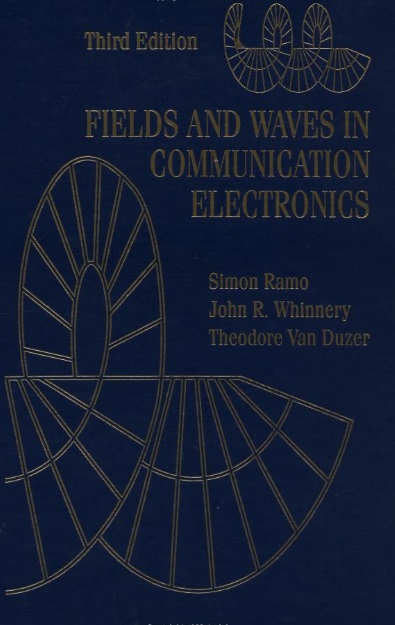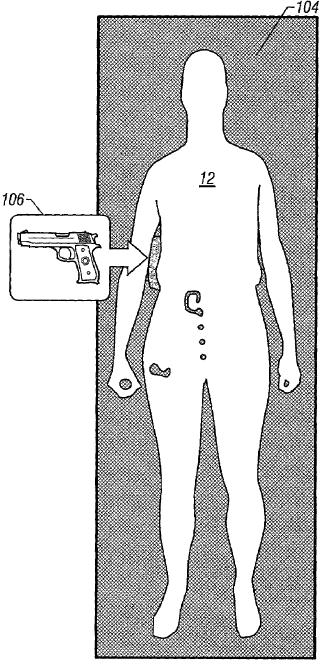
Last week, I shared a photo (right) with my Facebook friends of my “guest lecture” to my daughters’ kindergarten class. I had a request for more information, and since I had already written out my lecture plan, I thought it would be fun to share what I taught. In addition, I’ll provide my review of what went well and what didn’t quite capture my students’ attention as well as I had hoped. My “class” involved three general topics: electricity, magnetism, and electrical safety.
Static Electricity:
- Balance of Charge: I explained how matter contains equal amounts of positive and negative charge. By rubbing certain kinds of materials against each other, one object collects charge and the other loses it.
- Conductors versus Insulators: I explained the difference between insulators (which hold charge in place) and conductors (which allow charge to move easily).
- Demonstration (Balloons and static electricity): This was one of the best, simplest, and most interactive experiments I did. I used a compressor to blow up some balloons, rubbed the balloons on my hair to transfer electric charge, and then I let the students take the charged balloons to pick up styrofoam packing peanuts. This went over well and several students were able to use the charged balloons to go fishing for the packing peanuts.
- Demonstration (Wimshurst Machine – sparks and (mild) shocks): The Wimshurst Machine has two counter-rotating disks that turn the mechanical force of rotation into electric charge separation. The machine can generate quite respectable voltages – on the order of almost 100 kilovolts in dry air (less if it is humid). So little charge is stored, however, that the currents are small and the shocks are not dangerous. I let the students individually give themselves mild shocks, then we held hands and formed a ring. I completed the electric circuit and everyone got a little shock as the electricity flowed through us. This repeats the famous 1746 experiment of Jean-Antoine Nollet in which he gathered a ring of about 200 monks to try to assess the speed at which an electric shock would transfer from monk to monk. All the monks were shocked virtually simultaneously, proving that the speed of electrical propagation is very high. Of course, we now understand that light is a form of electrical phenomena and that electricity, like light, propagates far too quickly (186,000 mi/sec or 300,000 km/s) to perceive in an earthly setting with human perception.

- Demonstration (Wimshurst Machine – Ben Franklin and lightning): Finally I took my Benjamin Franklin Action Figure, provided him with a 16 gauge copper wire kite string (and kite) and let him fly it next to the charged Wimshurst machine (the wire “kite string” was grounded to the machine). I got some respectable sparks into Ben’s kite. I explained that lightning is formed when the electricity in the air builds up and then discharges in great big sparks like the ones from the Wimshurst machine. Ben proved that lightning was just great big electric sparks, but it was a very dangerous experiment and he almost got himself killed. This also gave me the opportunity to warn against kite flying in electrical storms or near power lines.
A really good book for high school or advanced younger students on the subject of static electricity is A. D. Moore’s Electrostatics: Exploring, Controlling and Using Static Electricity/Includes the Dirod Manual. I wouldn’t recommend it for the kindergarten level, but it would be a good reference for a lower elementary teacher who wants to be able to answer the deep and probing questions elementary students are capable of concocting.
Current and Magnetism:
- Magnets, iron and meteors: I brought in my meteorite and explained that long ago people did not know how to make iron, so the only iron they had was iron that fell from the sky. A few children were incredulous that the big rock I was showing them fell from the sky. Fortunately the teacher backed me up! I explained that iron can have charges flowing around in tiny circles that lets them attract other pieces of iron.

- Demonstration (Flowing current): I used my Electric Circuits Kit Book for this demonstration. I explained that batteries can push charges through conductors. The Kit Book has some simple circuits that can be configured to light a bulb, spin a motor, or sound a buzzer – some good examples of what we can make electricity do. This is the perfect introduction to electricity and electric circuits for a youngster not quite ready for Ohm’s Law, but able to understand closed loops, and ready to try mastering series and parallel hook-ups. It was a bit too advanced for my kindergarteners except as a demonstration.
- Demonstration (Turning a Nail into a Magnet): I used the Electric Circuits Kit Book to wrap a wire around a nail and demonstrate how the electric current turns the nail into a magnet. I should how it could attract and pick up paperclips. This could easily have been done with a D-cell a nail and some wire.
- I discussed how the Earth is a big magnet, and compasses point to the magnetic poles.
- Demonstration (Magnetic Compass): this was the biggest disappointment. I invested in a class set of little tiny toy compasses – just $0.19 each! There was a reason they were so inexpensive – I mean cheap. The compass needle… is PLASTIC! Kinda defeats the purpose of a compass, wouldn’t you think? I only had one real compass because it was too late to order any more and students were getting bored. I skipped to the final magnetism demonstration.
- Demonstration (Simple electric motor): this didn’t work very well either. I need to find a better simple motor.
Electrical Safety
Electricity helps us do many things, but it must be treated with care and respect. Electricity can hurt people and cause fires. In this section I focused on electricity in the home – what is does, and how to use it safely. The National Fire Protection Association (NFPA) was a helpful source of lesson plan ideas on electrical safety.
- What things use electricity? We discussed household electrical appliances, lights, etc. and all the things electricity can make happen. Then I concluded by reviewing a several safety tips.
- Stay away from transformers and power lines (particularly when flying kites).
- Stay away from hot light bulbs.
- Never stick anything into electrical outlets (or toasters).
- Electricity and water don’t mix – only touch switches with dry hands, and don’t use electricity near sinks or bath tubs.
- Never yank a cord.
- Let grown-ups plug in or turn on electrical appliances (particularly toasters), until a grown-up has shown you how to do it safely and says you may.
- Demonstration (Shorted Power Cord): For my finale, I wanted to do an experiment to show how dangerous electricity can be. I took a twin lead power cord, I carefully stripped the stranded wire, and I connected one of the tiny strands from one side with one of the tiny strands from the other side. I put the shorted cable under a clear plastic dome (to capture any flying debris) and on a small sheet of plywood to save the floor from being scorched. I plugged it in – FLASH and BANG! The surge of current overheats the wire at the weakest point – the high resistance short, and vaporizes the copper. I had practiced this several times beforehand to know what to expect and I insisted on a wide margin between the shorted wire and the students. Exciting, but not too scary, this seems to have driven home the point that electricity is powerful and must be treated with care.
Overall, I tried to do too much. This material would have been better as three one hour or so lectures – not a single one hour lecture. Also I needed to configure my demonstrations so more of the students could engage in the hands on activities. It was difficult keeping their attention while they were waiting their turn to use the nail magnet or see how a magnet would effect my compass, for instance. Hands-on interactive learning seemed to be the most effective technique. I found my guest lecture a fun and interesting experience, and I’m looking forward to playing teacher again sometime soon.
[iframe: src=”http://rcm.amazon.com/e/cm?lt1=_blank&bc1=000000&IS2=1&bg1=FFFFFF&fc1=000000&lc1=0000FF&t=uwbantennacom-20&o=1&p=8&l=as1&m=amazon&f=ifr&md=10FE9736YVPPT7A0FBG2&asins=1885540043″ frameborder=”0″ width=”120px” height=”240px” scrolling=”no”] [iframe: src=”http://rcm.amazon.com/e/cm?lt1=_blank&bc1=000000&IS2=1&bg1=FFFFFF&fc1=000000&lc1=0000FF&t=uwbantennacom-20&o=1&p=8&l=as1&m=amazon&f=ifr&md=10FE9736YVPPT7A0FBG2&asins=B0006FU92S” frameborder=”0″ width=”120px” height=”240px” scrolling=”no”]
Wimshurst Machines
[iframe: src=”http://rcm.amazon.com/e/cm?lt1=_blank&bc1=000000&IS2=1&bg1=FFFFFF&fc1=000000&lc1=0000FF&t=uwbantennacom-20&o=1&p=8&l=as1&m=amazon&f=ifr&md=10FE9736YVPPT7A0FBG2&asins=B000RZO8RO” frameborder=”0″ width=”120px” height=”240px” scrolling=”no”] [iframe: src=”http://rcm.amazon.com/e/cm?lt1=_blank&bc1=000000&IS2=1&bg1=FFFFFF&fc1=000000&lc1=0000FF&t=uwbantennacom-20&o=1&p=8&l=as1&m=amazon&f=ifr&md=10FE9736YVPPT7A0FBG2&asins=B003C1RI68″ frameborder=”0″ width=”120px” height=”240px” scrolling=”no”] [iframe: src=”http://rcm.amazon.com/e/cm?lt1=_blank&bc1=000000&IS2=1&bg1=FFFFFF&fc1=000000&lc1=0000FF&t=uwbantennacom-20&o=1&p=8&l=as1&m=amazon&f=ifr&md=10FE9736YVPPT7A0FBG2&asins=B002XOO4KS” frameborder=”0″ width=”120px” height=”240px” scrolling=”no”]


